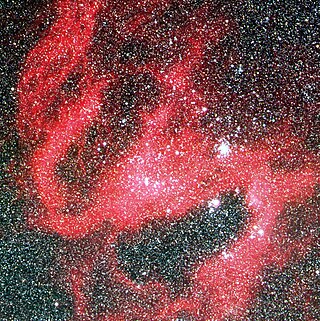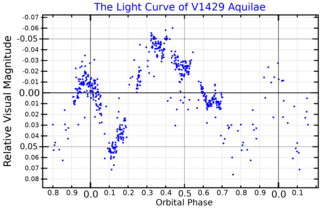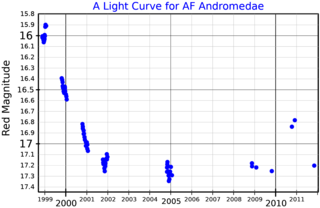
S Doradus is one of the brightest stars in the Large Magellanic Cloud (LMC), a satellite galaxy of the Milky Way, located roughly 160,000 light-years away. The star is a luminous blue variable, and one of the most luminous stars known, having a luminosity varying widely above and below 1,000,000 times the luminosity of the Sun, although it is too far away to be seen with the naked eye.

Luminous blue variables (LBVs) are massive evolved stars that show unpredictable and sometimes dramatic variations in their spectra and brightness. They are also known as S Doradus variables after S Doradus, one of the brightest stars of the Large Magellanic Cloud. They are considered to be rare.

P Cygni is a variable star in the constellation Cygnus. The designation "P" was originally assigned by Johann Bayer in Uranometria as a nova. Located about 5,300 light-years from Earth, it is a hypergiant luminous blue variable (LBV) star of spectral type B1-2 Ia-0ep that is one of the most luminous stars in the Milky Way.
Alpha Cygni variables are variable stars which exhibit non-radial pulsations, meaning that some portions of the stellar surface are contracting at the same time other parts expand. They are supergiant stars of spectral types B or A. Variations in brightness on the order of 0.1 magnitudes are associated with the pulsations, which often seem irregular, due to beating of multiple pulsation periods. The pulsations typically have periods of several days to several weeks.

A yellow hypergiant (YHG) is a massive star with an extended atmosphere, a spectral class from A to K, and, starting with an initial mass of about 20–60 solar masses, has lost as much as half that mass. They are amongst the most visually luminous stars, with absolute magnitude (MV) around −9, but also one of the rarest, with just 20 known in the Milky Way and six of those in just a single cluster. They are sometimes referred to as cool hypergiants in comparison with O- and B-type stars, and sometimes as warm hypergiants in comparison with red supergiants.

AG Carinae is a star in the constellation Carina. It is classified as a luminous blue variable (LBV) and is one of the most luminous stars in the Milky Way. The great distance and intervening dust mean that the star is not usually visible to the naked eye; its apparent brightness varies erratically between magnitude 5.7 and 9.0.

A hypergiant (luminosity class 0 or Ia+) is a very rare type of star that has an extremely high luminosity, mass, size and mass loss because of its extreme stellar winds. The term hypergiant is defined as luminosity class 0 (zero) in the MKK system. However, this is rarely seen in literature or in published spectral classifications, except for specific well-defined groups such as the yellow hypergiants, RSG (red supergiants), or blue B(e) supergiants with emission spectra. More commonly, hypergiants are classed as Ia-0 or Ia+, but red supergiants are rarely assigned these spectral classifications. Astronomers are interested in these stars because they relate to understanding stellar evolution, especially star formation, stability, and their expected demise as supernovae.

Zeta1 Scorpii is a B-type hypergiant star in the constellation of Scorpius. It has an apparent visual magnitude which varies between 4.66 and 4.86. It is a member of the Scorpius OB1 association, and the open star cluster NGC 6231, also known as the "Northern jewel box" cluster. Around 36 times as massive as the Sun, it is also one of the most luminous stars known in the Galaxy, with an estimated bolometric luminosity of around 850,000 times that of the Sun and a radius 103 times that of the Sun.

HD 5980 is a multiple star system on the outskirts of NGC 346 in the Small Magellanic Cloud (SMC) and is one of the brightest stars in the SMC.

WR 22, also known as V429 Carinae or HR 4188, is an eclipsing binary star system in the constellation Carina. The system contains a Wolf-Rayet (WR) star that is one of the most massive and most luminous stars known, and is also a bright X-ray source due to colliding winds with a less massive O class companion. Its eclipsing nature and apparent magnitude make it very useful for constraining the properties of luminous hydrogen-rich WR stars.

HD 168625 is a blue hypergiant star and candidate luminous blue variable located in the constellation of Sagittarius easy to see with amateur telescopes. It forms a visual pair with the also blue hypergiant HD 168607 and is located to the south-east of M17, the Omega Nebula.

HD 168607 is a blue hypergiant and luminous blue variable (LBV) star located in the constellation of Sagittarius, easy to see with amateur telescopes. It forms a pair with HD 168625, also a blue hypergiant and possible luminous blue variable, that can be seen at the south-east of M17, the Omega Nebula.

V1429 Aquilae is a candidate luminous blue variable multiple star system located in the constellation of Aquila. It is often referred to by its Mount Wilson Observatory catalog number as MWC 314. It is a hot luminous star with strong emission lines in its spectrum.

AS 314, also known as V452 Scuti, is a protoplanetary nebula once believed to be a white hypergiant star or luminous blue variable located in the constellation of Scutum. It has an apparent magnitude of 9.85 and can be seen with small telescopes.
R99 is a star in the Large Magellanic Cloud in the constellation Dorado. It is classified as a possible luminous blue variable and is one of the most luminous stars known.

V915 Scorpii is an orange hypergiant variable star in the constellation Scorpius.
WR 111 is a Wolf-Rayet (WR) star in the constellation Sagittarius. It is magnitude 7.8 and lies about 5,150 light-years away. It is one of the brightest and most closely studied WR stars.

R71 is a star in the Large Magellanic Cloud (LMC) in the constellation Mensa. It is classified as a luminous blue variable and is one of the most luminous stars in the LMC. It lies three arc-minutes southwest of the naked-eye star β Mensae.

AF Andromedae is a luminous blue variable (LBV), a type of variable star. The star is one of the most luminous variables in M31, the Andromeda Galaxy.
HD 37836 is a candidate luminous blue variable located in the Large Magellanic Cloud and one of the brightest stars in its galaxy.















